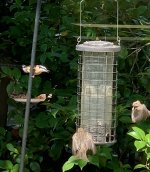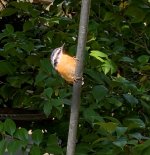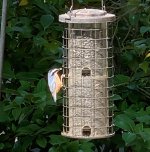duncankitchin
Member
Greetings - my first post here in many years. We have just moved to a new location in NW Oregon (97124 ZIP code) further out from the suburbs, and have found ourselves with a multitude of new and interesting birds to identify. We have several feeders set up with different seeds/suet, and have many birds that we recognize stopping by, along with many others we have never seen before.
There are a number of tree-clinging birds that are new to me, the most common of which I'm pretty sure is a red-breasted nuthatch. I have some pictures I will post later. In the meantime, there is a less-frequent visitor that I'm tentatively identifying as a downy woodpecker.
Observations: mostly dark brown to black, with white underbody and black/white stripes on the face, lighter spots on the wings. Clings only to the trunk of trees; I have never seen it on a branch. Unlike the nuthatches, which seem to be very comfortable clinging to trees and feeders at any orientation, the ? woodpecker always wants to be vertical. It seems to like a suet block (apparently intended to attract woodpeckers specifically) that is in a feeder designed for woodpeckers. It will bounce backwards and forwards occasionally between the feeder and a large-ish maple tree nearby.
I don't have a good absolute idea of scale, but it's bigger than a chickadee and smaller than a robin. Maybe about 5 1/2"?
Hopefully the below video link should work:
mp4 video on Dropbox
any thoughts on ID gratefully received.
There are a number of tree-clinging birds that are new to me, the most common of which I'm pretty sure is a red-breasted nuthatch. I have some pictures I will post later. In the meantime, there is a less-frequent visitor that I'm tentatively identifying as a downy woodpecker.
Observations: mostly dark brown to black, with white underbody and black/white stripes on the face, lighter spots on the wings. Clings only to the trunk of trees; I have never seen it on a branch. Unlike the nuthatches, which seem to be very comfortable clinging to trees and feeders at any orientation, the ? woodpecker always wants to be vertical. It seems to like a suet block (apparently intended to attract woodpeckers specifically) that is in a feeder designed for woodpeckers. It will bounce backwards and forwards occasionally between the feeder and a large-ish maple tree nearby.
I don't have a good absolute idea of scale, but it's bigger than a chickadee and smaller than a robin. Maybe about 5 1/2"?
Hopefully the below video link should work:
mp4 video on Dropbox
any thoughts on ID gratefully received.






